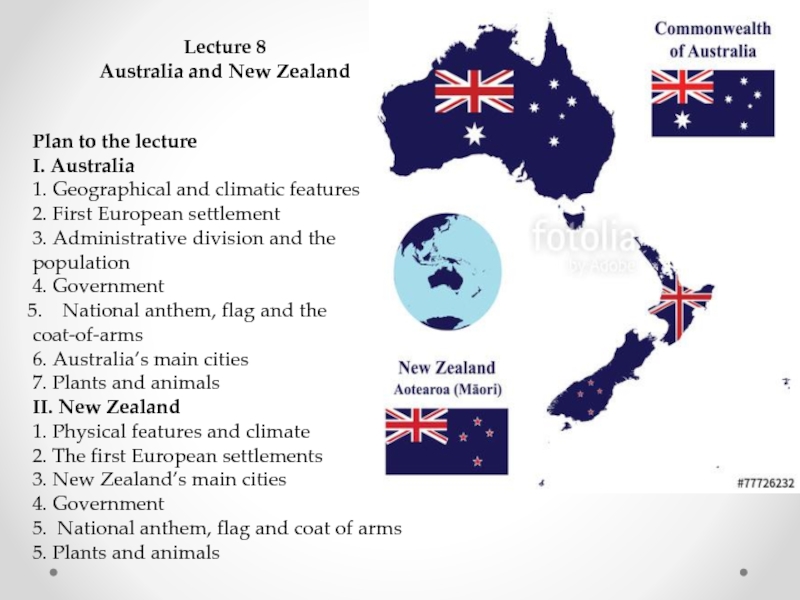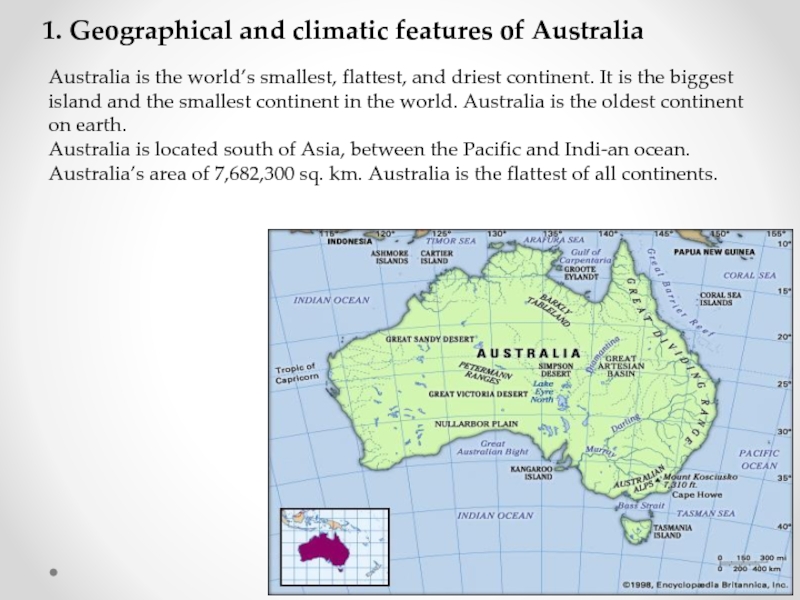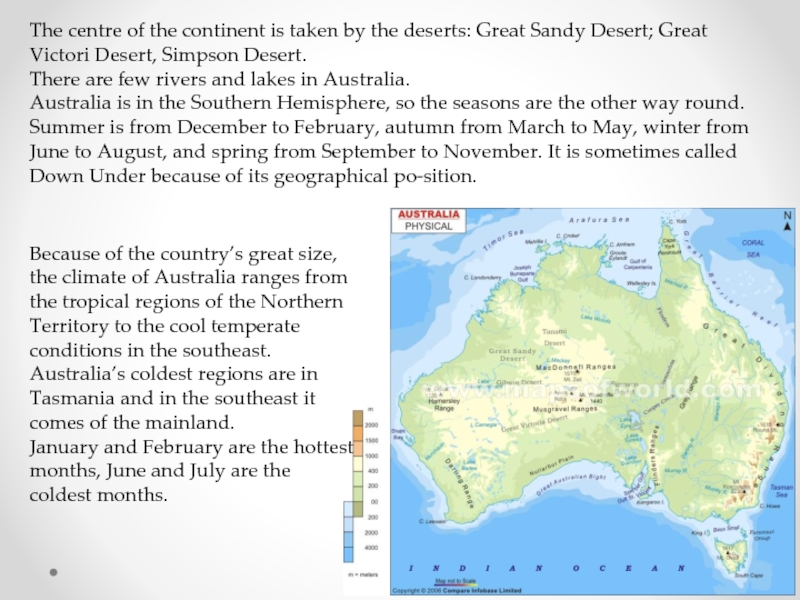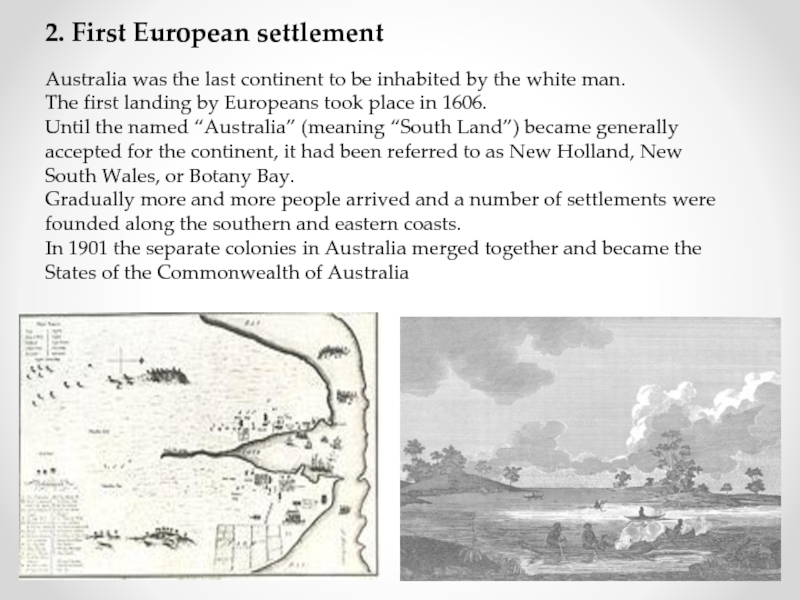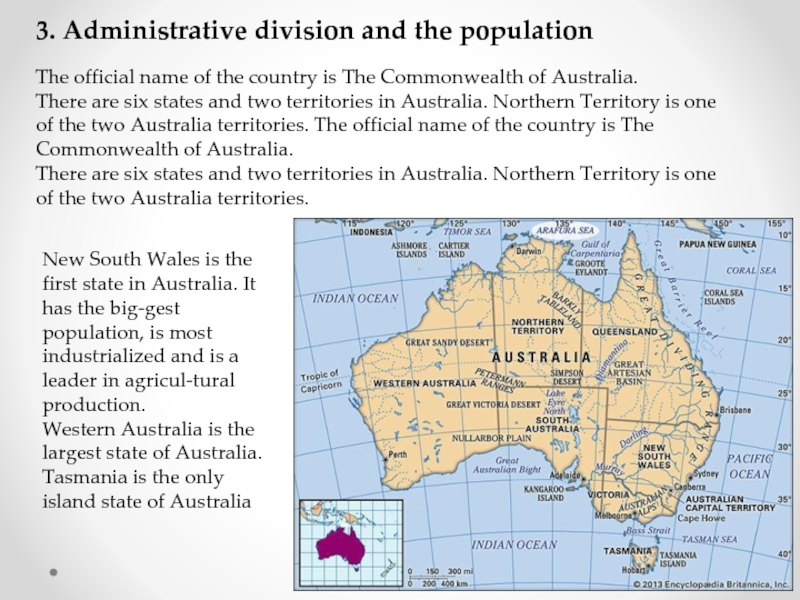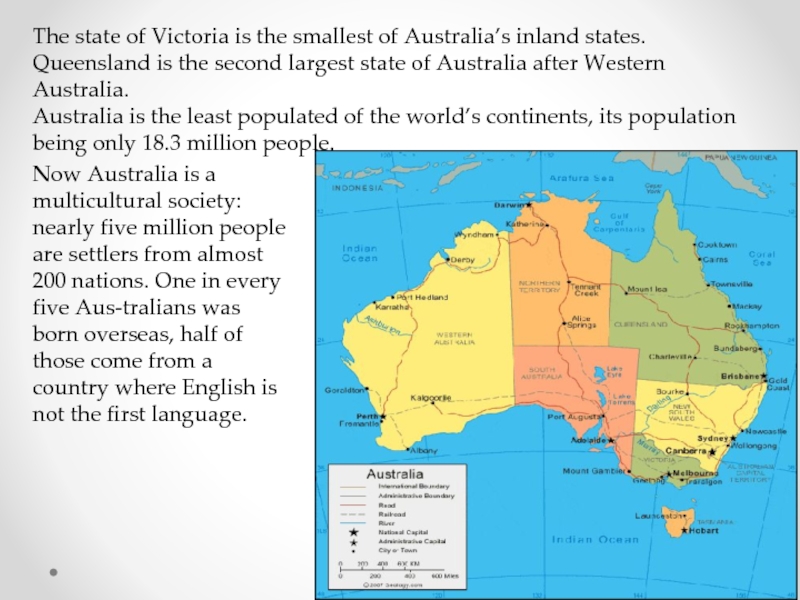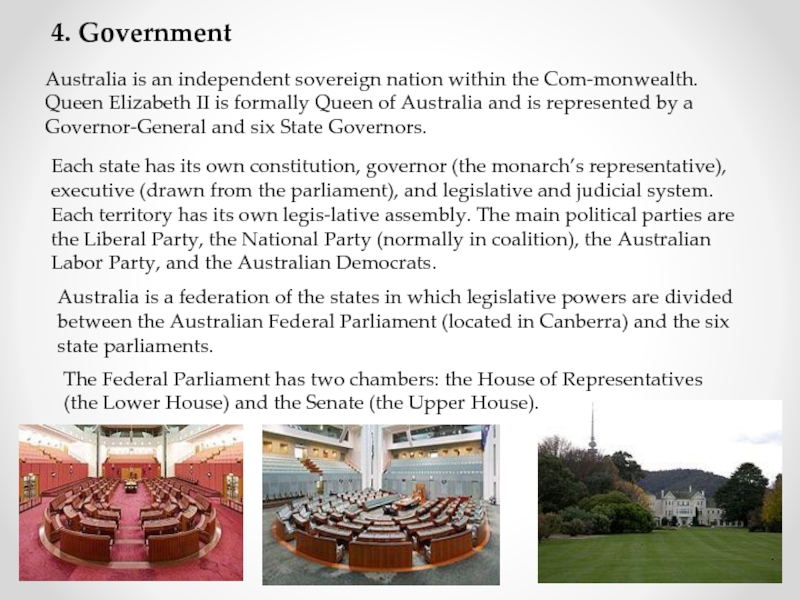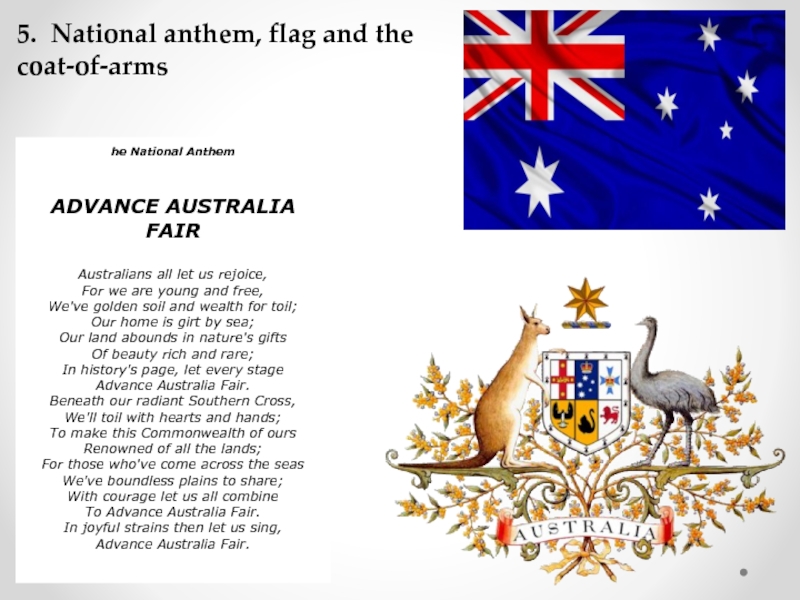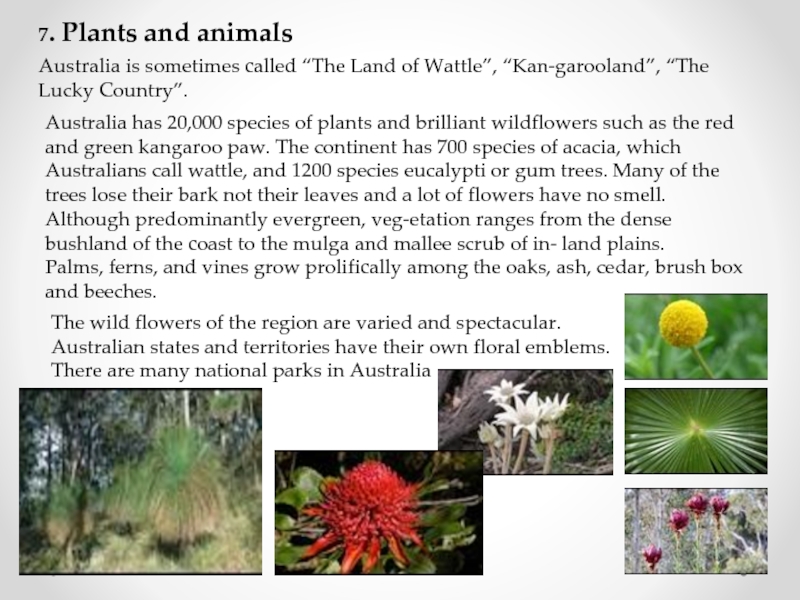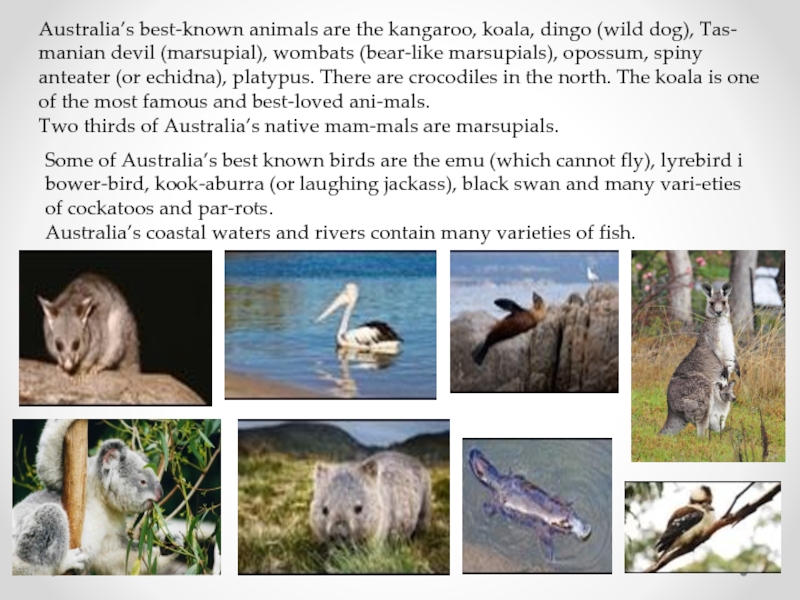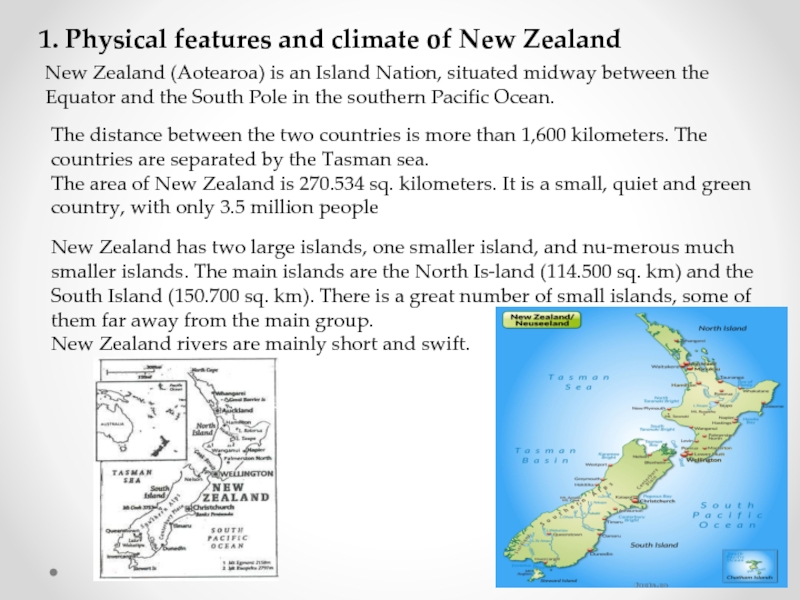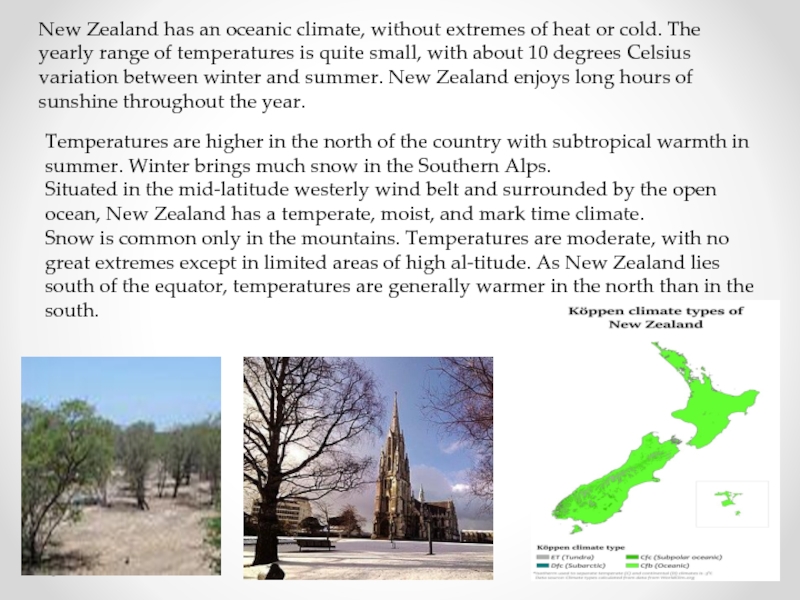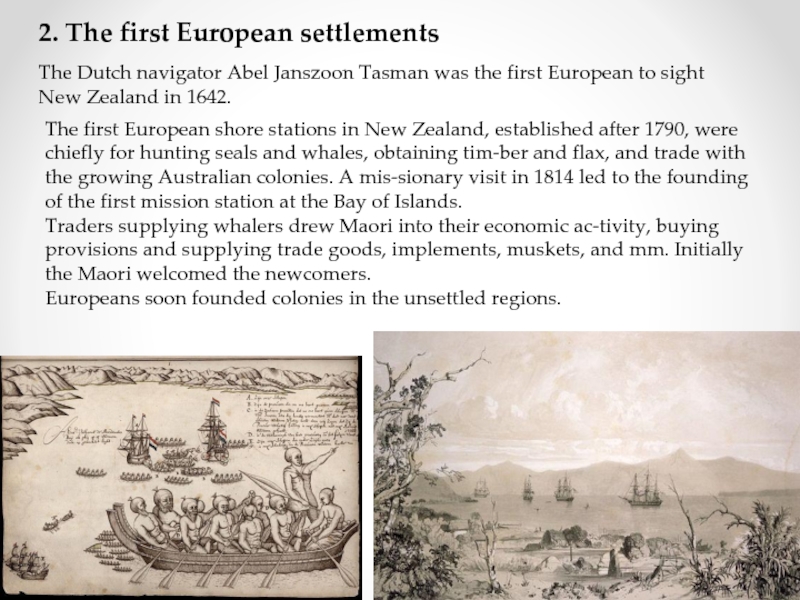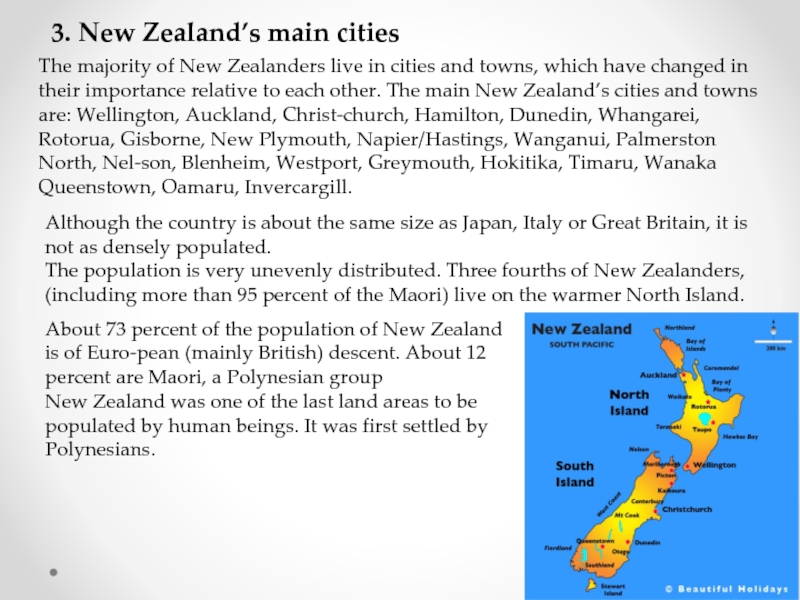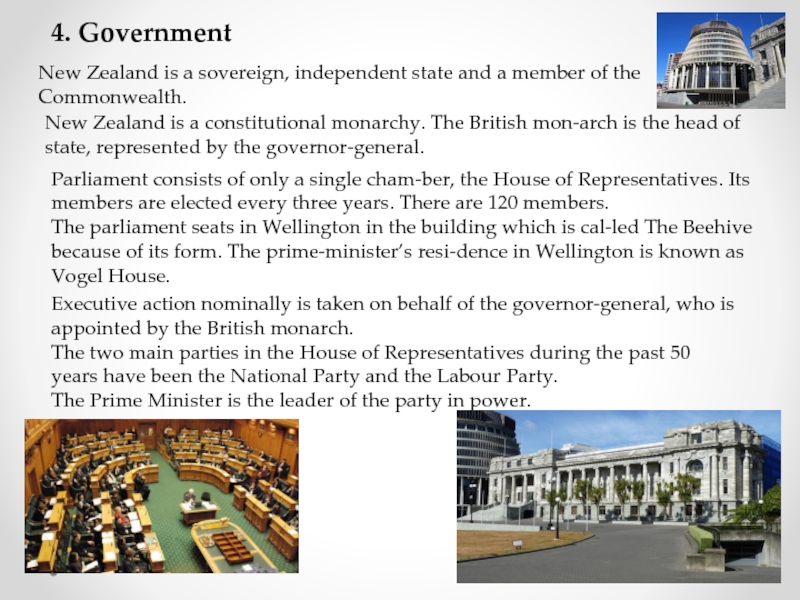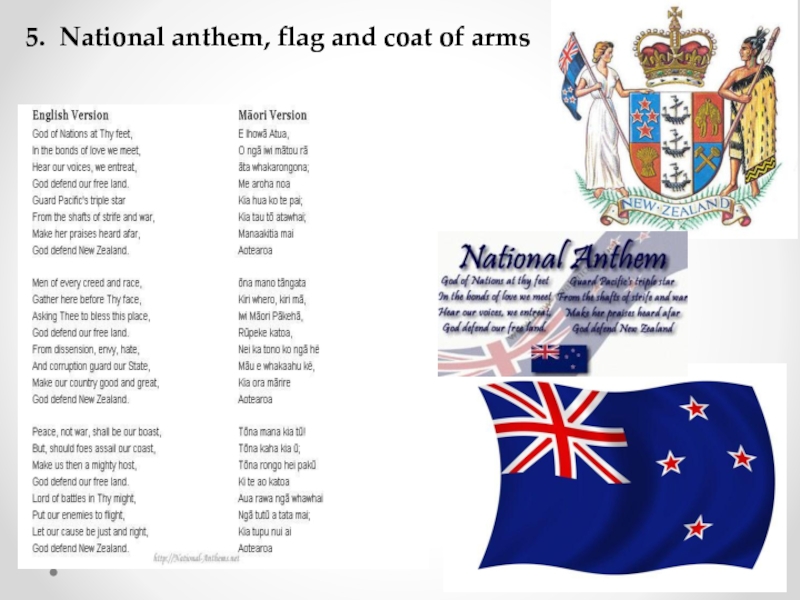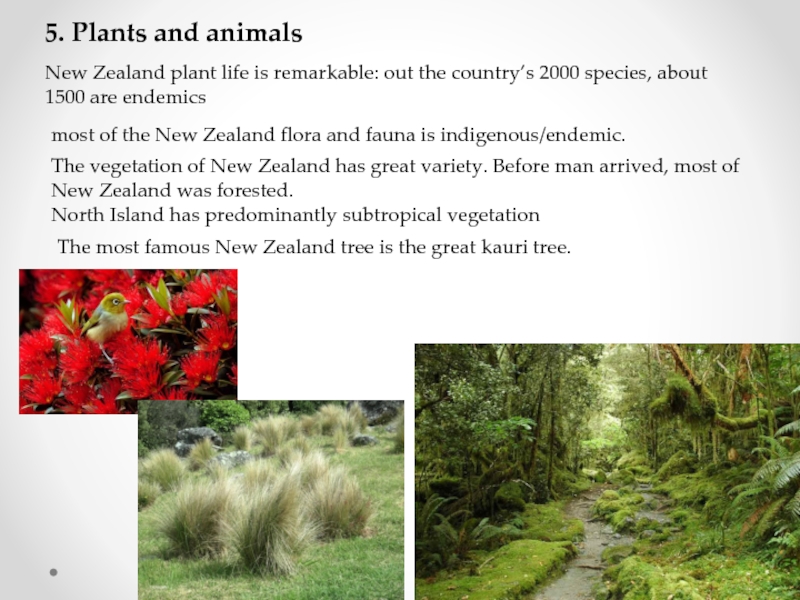- Главная
- Разное
- Дизайн
- Бизнес и предпринимательство
- Аналитика
- Образование
- Развлечения
- Красота и здоровье
- Финансы
- Государство
- Путешествия
- Спорт
- Недвижимость
- Армия
- Графика
- Культурология
- Еда и кулинария
- Лингвистика
- Английский язык
- Астрономия
- Алгебра
- Биология
- География
- Детские презентации
- Информатика
- История
- Литература
- Маркетинг
- Математика
- Медицина
- Менеджмент
- Музыка
- МХК
- Немецкий язык
- ОБЖ
- Обществознание
- Окружающий мир
- Педагогика
- Русский язык
- Технология
- Физика
- Философия
- Химия
- Шаблоны, картинки для презентаций
- Экология
- Экономика
- Юриспруденция
Australia and New Zealand презентация
Содержание
- 1. Australia and New Zealand
- 2. 1. Geographical and climatic features of Australia
- 3. The centre of the continent is taken
- 4. 2. First European settlement Australia was the
- 5. 3. Administrative division and the population The
- 6. The state of Victoria is the smallest
- 7. 4. Government Australia is an independent sovereign
- 8. he National Anthem ADVANCE AUSTRALIA
- 9. 6. Australia’s main cities Australia’s people are
- 10. 7. Plants and animals Australia is sometimes
- 11. Australia’s best-known animals are the kangaroo, koala,
- 12. 1. Physical features and climate of New
- 13. New Zealand has an oceanic climate, without
- 14. 2. The first European settlements The Dutch
- 15. 3. New Zealand’s main cities The majority
- 16. 4. Government New Zealand is a sovereign,
- 17. 5. National anthem, flag and coat of arms
- 18. 5. Plants and animals New Zealand plant
- 19. In New Zealand one can see the
Слайд 1Lecture 8
Australia and New Zealand
Plan to the lecture
I. Australia
1. Geographical and
2. First European settlement
3. Administrative division and the
population
4. Government
National anthem, flag and the
coat-of-arms
6. Australia’s main cities
7. Plants and animals
II. New Zealand
1. Physical features and climate
2. The first European settlements
3. New Zealand’s main cities
4. Government
5. National anthem, flag and coat of arms
5. Plants and animals
Слайд 21. Geographical and climatic features of Australia
Australia is the world’s smallest,
Australia is located south of Asia, between the Pacific and Indian ocean. Australia’s area of 7,682,300 sq. km. Australia is the flattest of all continents.
Слайд 3The centre of the continent is taken by the deserts: Great
There are few rivers and lakes in Australia.
Australia is in the Southern Hemisphere, so the seasons are the other way round. Summer is from December to February, autumn from March to May, winter from June to August, and spring from September to November. It is sometimes called Down Under because of its geographical position.
Because of the country’s great size, the climate of Australia ranges from the tropical regions of the Northern Territory to the cool temperate conditions in the southeast. Australia’s coldest regions are in Tasmania and in the southeast it comes of the mainland.
January and February are the hottest months, June and July are the coldest months.
Слайд 42. First European settlement
Australia was the last continent to be inhabited
The first landing by Europeans took place in 1606.
Until the named “Australia” (meaning “South Land”) became generally accepted for the continent, it had been referred to as New Holland, New South Wales, or Botany Bay.
Gradually more and more people arrived and a number of settlements were founded along the southern and eastern coasts.
In 1901 the separate colonies in Australia merged together and became the States of the Commonwealth of Australia
Слайд 53. Administrative division and the population
The official name of the country
There are six states and two territories in Australia. Northern Territory is one of the two Australia territories. The official name of the country is The Commonwealth of Australia.
There are six states and two territories in Australia. Northern Territory is one of the two Australia territories.
New South Wales is the first state in Australia. It has the biggest population, is most industrialized and is a leader in agricultural production.
Western Australia is the largest state of Australia.
Tasmania is the only island state of Australia
Слайд 6The state of Victoria is the smallest of Australia’s inland states.
Queensland
Australia is the least populated of the world’s continents, its population being only 18.3 million people.
Now Australia is a multicultural society: nearly five million people are settlers from almost 200 nations. One in every five Australians was born overseas, half of those come from a country where English is not the first language.
Слайд 74. Government
Australia is an independent sovereign nation within the Commonwealth. Queen
Each state has its own constitution, governor (the monarch’s representative), executive (drawn from the parliament), and legislative and judicial system. Each territory has its own legislative assembly. The main political parties are the Liberal Party, the National Party (normally in coalition), the Australian Labor Party, and the Australian Democrats.
Australia is a federation of the states in which legislative powers are divided between the Australian Federal Parliament (located in Canberra) and the six state parliaments.
The Federal Parliament has two chambers: the House of Representatives (the Lower House) and the Senate (the Upper House).
Слайд 8he National Anthem
ADVANCE AUSTRALIA FAIR
Australians all let us rejoice,
For we
We've golden soil and wealth for toil;
Our home is girt by sea;
Our land abounds in nature's gifts
Of beauty rich and rare;
In history's page, let every stage
Advance Australia Fair.
Beneath our radiant Southern Cross,
We'll toil with hearts and hands;
To make this Commonwealth of ours
Renowned of all the lands;
For those who've come across the seas
We've boundless plains to share;
With courage let us all combine
To Advance Australia Fair.
In joyful strains then let us sing,
Advance Australia Fair.
5. National anthem, flag and the coat-of-arms
Слайд 96. Australia’s main cities
Australia’s people are city dwellers. Less than one
More and more of Australia’s people are moving away from rural areas into the towns and cities.
Most important among them are: Adelaide, Alice Springs, Brisbane, Darwin, Melbourne, Perth, Sydney, Hobart, Geelong, Newcastle, Townsville, Wollongong.
More than 80 per cent of Australia’s population live in the capital cities of the six states (Sydney, Brisbane, Adelaide, Hobart, Melbourne, Perth).
Слайд 107. Plants and animals
Australia is sometimes called “The Land of Wattle”,
Australia has 20,000 species of plants and brilliant wildflowers such as the red and green kangaroo paw. The continent has 700 species of acacia, which Australians call wattle, and 1200 species eucalypti or gum trees. Many of the trees lose their bark not their leaves and a lot of flowers have no smell.
Although predominantly evergreen, vegetation ranges from the dense bushland of the coast to the mulga and mallee scrub of in- land plains.
Palms, ferns, and vines grow prolifically among the oaks, ash, cedar, brush box and beeches.
The wild flowers of the region are varied and spectacular.
Australian states and territories have their own floral emblems.
There are many national parks in Australia
Слайд 11Australia’s best-known animals are the kangaroo, koala, dingo (wild dog), Tasmanian
Two thirds of Australia’s native mammals are marsupials.
Some of Australia’s best known birds are the emu (which cannot fly), lyrebird i bower-bird, kookaburra (or laughing jackass), black swan and many varieties of cockatoos and parrots.
Australia’s coastal waters and rivers contain many varieties of fish.
Слайд 121. Physical features and climate of New Zealand
New Zealand (Aotearoa) is
The distance between the two countries is more than 1,600 kilometers. The countries are separated by the Tasman sea.
The area of New Zealand is 270.534 sq. kilometers. It is a small, quiet and green country, with only 3.5 million people
New Zealand has two large islands, one smaller island, and numerous much smaller islands. The main islands are the North Island (114.500 sq. km) and the South Island (150.700 sq. km). There is a great number of small islands, some of them far away from the main group.
New Zealand rivers are mainly short and swift.
Слайд 13New Zealand has an oceanic climate, without extremes of heat or
Temperatures are higher in the north of the country with subtropical warmth in summer. Winter brings much snow in the Southern Alps.
Situated in the mid-latitude westerly wind belt and surrounded by the open ocean, New Zealand has a temperate, moist, and mark time climate.
Snow is common only in the mountains. Temperatures are moderate, with no great extremes except in limited areas of high altitude. As New Zealand lies south of the equator, temperatures are generally warmer in the north than in the south.
Слайд 142. The first European settlements
The Dutch navigator Abel Janszoon Tasman was
The first European shore stations in New Zealand, established after 1790, were chiefly for hunting seals and whales, obtaining timber and flax, and trade with the growing Australian colonies. A missionary visit in 1814 led to the founding of the first mission station at the Bay of Islands.
Traders supplying whalers drew Maori into their economic activity, buying provisions and supplying trade goods, implements, muskets, and mm. Initially the Maori welcomed the newcomers.
Europeans soon founded colonies in the unsettled regions.
Слайд 153. New Zealand’s main cities
The majority of New Zealanders live in
Although the country is about the same size as Japan, Italy or Great Britain, it is not as densely populated.
The population is very unevenly distributed. Three fourths of New Zealanders, (including more than 95 percent of the Maori) live on the warmer North Island.
About 73 percent of the population of New Zealand is of European (mainly British) descent. About 12 percent are Maori, a Polynesian group
New Zealand was one of the last land areas to be populated by human beings. It was first settled by Polynesians.
Слайд 164. Government
New Zealand is a sovereign, independent state and a member
New Zealand is a constitutional monarchy. The British monarch is the head of state, represented by the governor-general.
Parliament consists of only a single chamber, the House of Representatives. Its members are elected every three years. There are 120 members.
The parliament seats in Wellington in the building which is called The Beehive because of its form. The prime-minister’s residence in Wellington is known as Vogel House.
Executive action nominally is taken on behalf of the governor-general, who is appointed by the British monarch.
The two main parties in the House of Representatives during the past 50 years have been the National Party and the Labour Party.
The Prime Minister is the leader of the party in power.
Слайд 185. Plants and animals
New Zealand plant life is remarkable: out the
most of the New Zealand flora and fauna is indigenous/endemic.
The vegetation of New Zealand has great variety. Before man arrived, most of New Zealand was forested.
North Island has predominantly subtropical vegetation
The most famous New Zealand tree is the great kauri tree.
Слайд 19In New Zealand one can see the world’s largest flightless parrot
There are 44 species of reptiles in the islands, but there are no snakes. There were two species of lizard
New Zealand has a large population of wild birds, including 23 native species: the flightless kiwi, takahe, kakapo, albatross and weka among them.
In the absence of predatory animals, New Zealand was a paradise for birds, the most interesting of which are flightless.
Some birds are peculiar to New Zealand, but many others, such as the tui, the fantail, and the bellbird, are closely related to Australian birds.
